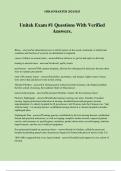©BRAINBARTER 2024/2025
Unitek Exam #1 Questions With Verified
Answers.
Illness - answer✔an abnormal process in which aspects of the social, emotional, or intellectual
condition and function of a person are diminished or impaired
causes of illness in ancient times - answer✔divine disfavor w/ god or bad spirits in the body
healing in ancient times - answer✔witchcraft, spells, rituals
pest-houses - answer✔19th century hospitals, allowed for widespread of infections because there
were no sanitary precautions
early 19th century nurses - answer✔alcoholics, prostitutes, and inmates. higher status women
were above that and did not work in that setting.
Theodor Fliedner - answer✔A German pastor in Kaiserswerth, Germany who helped establish
the first school of nursing, the Lutheran Order of Deaconesses
kaiserwerth program - answer✔the program Fliedner created. the first nursing school
Florence Nightingale - answer✔Established sanitary nursing care units. Founder of modern
nursing. began professional education of nursing. attended kaiserwerth program. became
superintendent of a charity hospital for ill governesses. led 38 nurses into the Crimean war, "lady
with the lamp". 1st nursing theorist. established nursing school at st. thomas hospital in london.
nightingale plan.
Nightingale Plan - answer✔Training practice established by the first nursing theorist; established
formal and practical instruction, as well as keeping complete student records. improved patient
care by such measures as good hygiene, sanitation, patient observation, record keeping, nutrition
improvements, and the use of medical equipment.
first protestant hospital on american shores - answer✔made by fliedner, called the passavant
hospital in pittsburg pensylvania. deaconesses began first formal education of nurses in the U.S.
1869 AMA suggested that every large hospital - answer✔establish and support its own school of
nursing
, ©BRAINBARTER 2024/2025
Dorothea Dix - answer✔A reformer and pioneer in the movement to treat the insane as mentally
ill, beginning in the 1820's, she was responsible for improving conditions in jails, poorhouses
and insane asylums throughout the U.S. and Canada. She succeeded in persuading many states to
assume responsibility for the care of the mentally ill. She served as the Superintendant of Nurses
for the Union Army during the Civil War.
Clara Barton - answer✔Launched the American Red Cross in 1881. An "angel" in the Civil War,
she treated the wounded in the field.
mary ann ball - answer✔One of the greatest nurse heroines of the Civil War. Championed the
rights and comforts of the soldiers; organized diet kitchens, laundries, ambulance service; and
supervised the nursing staff.
Linda Richards - answer✔first trained nurse in the US, first nursing and hospital records,
credited with founding present day documenting system
isabel hampton robb - answer✔A leader in nursing and nursing education; organized the nursing
school at Johns Hopkins Hospital; initiated policies that included limiting the number of hours in
a days work and wrote a textbook to help student learning; the first president of the Nurses
Associated Alumnae of the United States and Canada (now American Nurses Association).
Lavinia Dock - answer✔Responsible, with Robb, for the organization of the American Society of
Superintendents of Training Schools, which evolved into the National League for Nursing
Education.
Mary Eliza Mahoney - answer✔first trained African American nurse in the US
Lilian D. Wald - answer✔responsible for the development of public health nursing through the
Henry street settlement
Mary Adelaide Nutting - answer✔Instrumental in moving nursing education into universities. the
first professor of nursing. developed curriculum and guidelines for students.
Mary Breckenridge (1920s) - answer✔Established the FNS/Frontier Nursing Services in 1925,
health care services for rural Kentucky, The FNS is still in operation today and provides vital
service to the rural communities of Kentucky.
Breckenridge collected data that clearly documented a significant decrease in mortality with the
nursing services provided by the FNS.
pioneer in nurse mid-wifery. obstetrician.
, ©BRAINBARTER 2024/2025
In 1911, the American Society of Superintendents of Training Schools became the _________ -
answer✔National League For Nursing Education, (NLNE), released their 1st nursing curriculum
plan.
WW1 - answer✔increase demand for nurses, looked for nurses with "good moral character and
professional qualifications", Army school of nursing(AKA: Nurse Corps/Army Heriatge Center
Foundation) is established when they realize the demand for trained nurses cannot be met.
After effects of war: most women had to return home to their jobs and homes, nurses had a bad
rep, nursing was still "service to the patient" which was the opposite of what the Nightingale
Plan wanted.
WW2 - answer✔high demand for trained nurses. Cadet Nurse Corps was established. Women
and men welcome.
after effects: lots stayed in the military role for good pay, prestige, and benefits compared to the
trash that civilian jobs gave nurses.
The Great Depression then caused a large nursing shortage.
ANA - answer✔American Nurses Association
Old uniforms - answer✔all white, maid or servant like, clean servitude, white pleated cap
21st century - answer✔women's health care issues, gender discrimination not allowed, nursing
advocated for human rights for all, a lot of people are medically undeserved for various reasons
like immigrants, homeless, poverty, insurance rates. There is always a nursing shortage.
YWCA - answer✔-Young Women's Christian Association
-first program to offer formal prep for practical nursing
NFLPN - answer✔National Federation of Licensed Practical Nurses. Founded in 1949.
Membership for students and graduates. They offer cervices, and they fight for us at state and
federal level.
NAPNES - answer✔National Association for Practical Nurse Education and Service
NLN - answer✔National League for Nursing; sets standards for excellence and innovation in
nursing education
Approved program - answer✔Program that meets minimum standards established by the state
agency responsible for overseeing education programs




